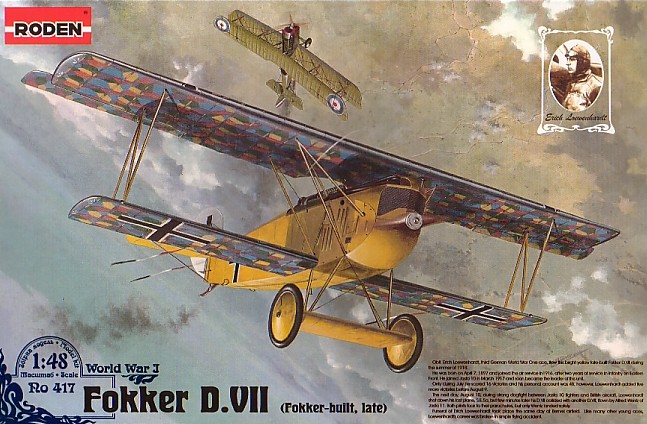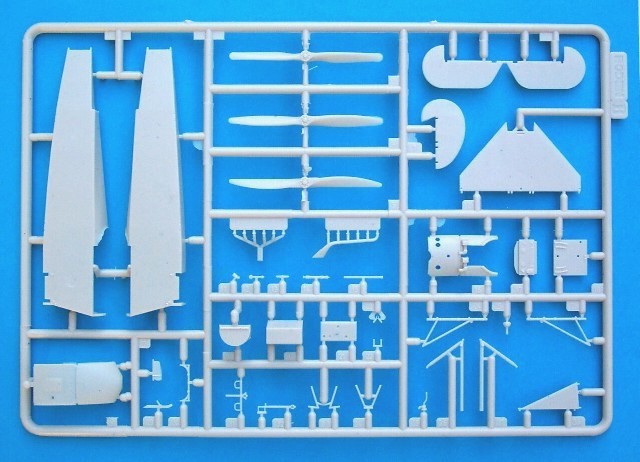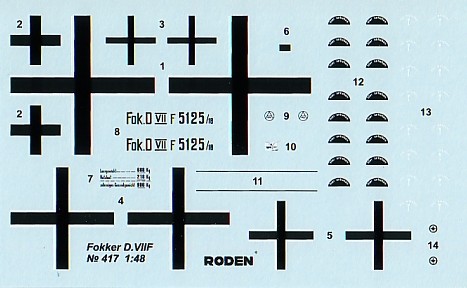|
Fokker D.VII
Fokker built, late

Roden,1/48 scale
S
u m m a r y
|
| Catalogue Number: |
Kit #417 - Fokker D.VII (Fokker
late build) |
| Scale: |
1/48 |
| Contents and Media: |
Six sprues of light grey plastic and
three sheets of decal |
| Price: |
USD$17.97 from Squadron.com
|
| Review Type: |
FirstLook |
| Advantages: |
Accurate, well-researched,
superb attention to detail. |
| Disadvantages: |
Some short moulding of lower
wing scallops. |
| Recommendation: |
Highly Recommended |
Reviewed by Robert Baumgartner

Roden's 1/48
scale Fokker D.VII (late Fokker build) is available online from Squadron.com
This is the second release in the Fokker D.VII family and it represents
a late built Fokker example. The sprues are the same as Roden’s earlier
version with the exception of sprue E. This contains the new cowling,
exhaust and radiator arrangement that was applicable to this variant.
There are five sprues in the familiar soft light grey plastic. These
contain 90 parts, which are cleanly moulded and exhibit excellent detail.
As with Roden’s previous example, everything matched up well with Ian
Stair’s drawings in the Albatros Productions series on the Fokker D.VII.
The fuselage halves are seen as separate pieces to the engine area so that
maximum use is made of the moulds. This is not a problem here, as test
fitting the two completed sub assemblies does not produce a headache.

Click the thumbnails below
to view larger images:
The fuselage halves are nicely done with tubular frame detail moulded
to their insides. Cleverly there are a couple of notches to allow for the
secure location of the lower wing “spars”. The fit is very tight when the
wing is added and care is needed not to introduce any anhedral.
The cockpit is quite comprehensive with the usual seat, rudder bar,
control column and floor being present. Added to this are the pressure
pump, compass, tachometer, rear screen and cross member. The inclusion of
a fuel tank and gauge is particularly noteworthy. Attention to detail can
also be seen in the instrument panel, which has been carefully modeled to
follow the usual Fokker layout.
The only obvious thing the modeler may choose to add here is the auxiliary
“throttle” lever and ignition control handle, both located on the port
side of the fuselage.
All these items fitted perfectly into the assembled fuselage.
Don’t worry about the ejector pin marks inside the fuselage. They have
been positioned so that they are not obvious when the cockpit is closed
up.
Both wings come as upper and lower halves with separate wingtips. The
surface detail on these is beautifully subtle and carries a very fine
rendition of the plywood sheathing.
The top wing has the correct underside taper towards the tips and
cutouts are present to accept the separate ailerons.
Roden has done a fine job here as the control horns pass securely
through the ailerons to produce a very strong fit. Taking care during the
cleanup of these parts will ensure that the hinges line up properly. This
same degree of excellence extends to the elevators and rudder. Hopefully
other kits will follow this “no fuss” approach.
Although represented on the upper wings, don’t forget to add stacking pads
to the lower ones. Plastic rod or a drop of adhesive will help out here.
As was the case with the earlier release, the top portions of the lower
wing halves are moulded a little short. Thus care needs to be exercised to
pad out the trailing edge to recreate the scallops. After the wings are
assembled, a little putty will be needed to blend in the wingtips. None of
this is hard to do.
The “front end” is designed so that the engine can be exposed. As a result
Roden have provided both the BMW and Mercedes engines along with the
supporting structure. This complex arrangement looks superb and will need
care during assembly.
Spare items that will be used on future releases include wheel covers,
propellers, axle wings and in this case, a Mercedes engine.
Roden’s previous D.VII showed that a bit of patience will be needed in
final assembly. If modeling a fully cowled version, thinning the inside of
the cabane entry hole will help immensely. There are many struts involved
so a lot of test fitting is needed to get things right. As usual, these
parts are moulded as near to scale as possible.
Three very different options are provided for:
a) Fokker D.V.IIF w/n 5125/18 flown by Hauptmann
Hermann Göring, Jagdgeschwader 1 October 1918.
Göring is credited with 22 victories although there is some controversy
about many of his claims. He went on to become Reichsmarschall in 1940 as
part of the Nazi organization and after WWII was found guilty of war
crimes. He cheated the hangman’s noose by committing suicide on October
15, 1946.
If choosing to do this aircraft, take note that Göring had part of the
port cockpit opening cut away and a handgrip added to allow easier entry.
A starboard photo also reveals the presence of a flare rack under the
cockpit rim along with a rearward protruding pistol flare tube.
b) Fokker D.V.IIF flown by Oblt. Bruno Loerzer,
Jasta 26 November 1918.
Loerzer was associated with a number of Units before finally taking
command of Jasta 26 in January 1917 and ultimately JG III a little over a
year later.
The Geschwader Kommandeur scored 21 of his eventual 44 victories leading
this formation, with the balance coming while with Jasta 26 and Kek J.
Like his good friend Göring, Bruno also survived WWI and went on to
take up a prominent position in the Luftwaffe. He died on 23 August 1960.
Modellers may like to note that another similarly marked D.VII belonged to
Loerzer except this was an earlier built Fokker product. The fuselage
stripes were wider and more even and the smaller upper wing crosses did
not extend all the way to the aileron trailing edge. A chance to make a
matching pair by adapting Roden’s earlier release perhaps?
c) Fokker D.V.IIF flown by Oblt. Erich Löwenhardt, Jasta 10, August 1918.
The highest scorer of the three options, Löwenhardt ended the war with
54 victories to become third on the list of top scoring German Aces of
WWI.
All of his victories were accomplished while with Jasta 10 which
included 8 balloons.
His life was to end on 10 August 1918 when after downing a SE5a, he
collided with Leutnant Alfred Wenz. Both men jumped from their stricken
aircraft but Löwenhardt’s parachute did not open.

Click the thumbnails below
to view larger images:
These decals come on three sheets. Two consist of lozenge, both upper and
lower, and the third contains the individual markings, national insignia
and stencil data.
The latter is a real bonus as these items are often missed in kits.
The individual colours were well printed although the crosses were
slightly out of register. Testing part of a decal in water showed that it
held together well and provided it was kept wet, was easily maneuvered on
the kit.
Roden continues their fine series of Fokker D.VII kits and show that
“standard” offerings are now becoming quite sophisticated. The consequence
is more care being required in assembly but the final result makes it all
worthwhile.
Highly Recommended
Thanks to
Squadron.com for the review
sample.
Review and Images Copyright © 2004 by
Robert Baumgartner
Page Created 09 March, 2004
Last updated 09 March, 2004
Back to HyperScale Main Page
Back to Reviews Page
|
Home | What's
New | Features
| Gallery |
Reviews | Reference
| Forum
| Search